David's Astronomy Pages
Notes - Session 640 (2018-12-04)
Notes
(S639)
Notes
Main
Home
Page
Notes
(S641)
David's Astronomy Pages
|
Notes (S639) |
Notes Main |
Home Page |
Notes (S641) |
Main aims
Equipment & Software
Highlights
Summary Plots & Logs
| Observing Result (2018-12-04, S640) | ||||||||||||||||||||||||||||||||||||||||||||||||||||||||||||
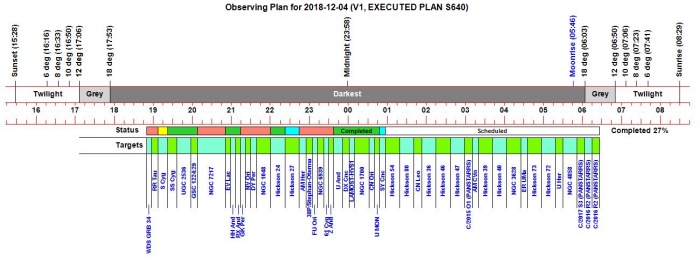 |
||||||||||||||||||||||||||||||||||||||||||||||||||||||||||||
|
||||||||||||||||||||||||||||||||||||||||||||||||||||||||||||
|
Night Sky Summary Plot -
2018-12-04 Top axis: Sky Brightness at Zenith (in ADU/s) Lefthand axis: Local Time (hh LT). Righthand axis: Sun Altitude (degs) Shutter/Telescope active from ~ 22:00 to ~ 01:30 |
||||||||||||||||||||||||||||||||||||||||||||||||||||||||||||
 |
Back to Top
Illustrations
|
Fig 1: AstroMain Program Crash at
23:28 Whilst recently patched code had caught a first exception in 'AnalyseStarsInImage' routine (an excepton that had caused Program Crash in the last session (S639) ) the program fell over a moment later in same routine with the same issue (ShowInventory commanded on image that hasn't been saved) The failure on target 61 Cyg is similar to a failure on target GK Per in session S638 where the crash came when handling the 1st locate framet taken with SBIG Camera following earlier attempted Foc2 autofocusing of TS80 guide scope using ZWO Camera (Cam2). The Cam2 code is new and a bug has lead to this knock-on issue in a routine that didn't previously suffer from any problems |
 |
Back to Top
PHD2 calibration successfully performed on the ZWO ASI ASCOM CAM profile, comprising ASI Camera (1) (ASCOM) with POTH.Hub (ASCOM) This is a neccessary step for mixing PHD2 autoguiding with AstroMain's access to ZWO ASI 178MC camera for focusing and medium field shots.
| Calibration for ZWO ASI ASCOM CAM Profile - 2018-12-04 |
 |
| Earlier Calibration for ZWO ASI1878MC Profile - 2017-11-14 |
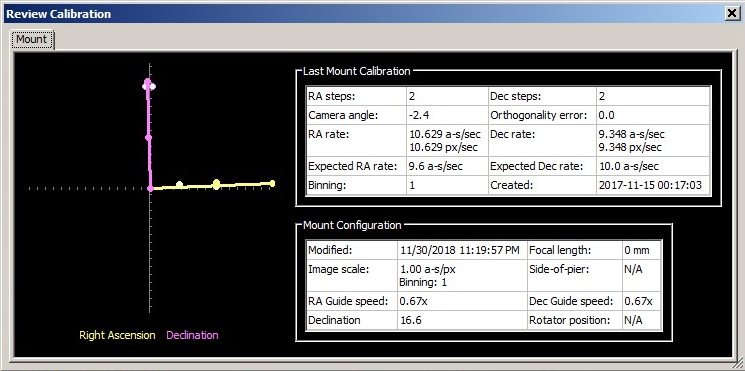 |
Back to Top
With temperatures down to -4 degC, a heavy frost and with the dome open all night a frost developed on the inside of the Dome This included some quite nice frost patterns on the inside surface of the Shutter. These patterns had melted slightly by the time I took a picture of them with a camera, but their main features can still be seen.
|
Frost Patterns on Dome Shutter (click on image to enlarge) |
 |
Back to Top
After parking the LX200 scope at 06:37 (following earlier computer carsh/restart) the AstroMain program was left running with connections to the Pulsar Dome (Parked) and LX200 Telescope (Parked) and the AstroGuard program was left running with connection to the Pulsar Dome
| AstroMain | AstroGuard | |||
| Time | Report Log | Time | Report Log | |
| 06:36 | ASCOM Dome (COM9): Started | 06:36 | ASCOM Dome (COM9): Started | |
| 09:11 | "Dome has changed from COM9 to COM4" | 09:11 | Detected Dome had moved from COM9 to COM4 | |
| An attempt will be made to restart the dome connection | An attempt will be made to restart the dome connection | |||
| ASCOM Dome (COM4): Started | ASCOM Dome (COM4): Started | |||
| 10:41 | Dome Port lost | No message from AstroGuard at this time | ||
| An attempt will be made to restart the dome connection | ||||
| ASCOM Dome (COM4): Started | ||||
| 11:45 | Dome Port lost | No message from AstroGuard at this time | ||
| An attempt will be made to restart the dome connection | ||||
| ASCOM Dome (COM4): Started | ||||
| 13:15 | Dome Port lost | |||
| An attempt will be made to restart the dome connection | No message from AstroGuard at this time | |||
| ASCOM Dome (COM4): Started | ||||
| ~ 14:40 | Dome Connection noticed to not be working from POTH Hub | |||
| 14:46 | ASCOM Dome Stopped | ASCOM Dome Stopped | ||
| 14:46 | ASCOM Dome (COM4): Started | ASCOM Dome (COM4): Started | ||
At some point (possibly in association with event at 09:11 but possibly later) it was noticed that an ASCOM error message had popped up saying that the Meade LX200GPS/R Telescope Driver had stopped working. (going into debug implied a possible Out of Memory exception, this was without any source code however )
| ASCOM Meade LX200GPS/R Telescope Driver stopped working |
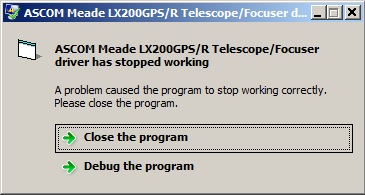 |
There was no change to the Pulsar Dome's COM port associated with a momentary
Power Grid outage at 14:06
(an event which has caused the COM Port for
Pegasus Ultimate Power Box to change)
Back to Top
At 2018-12-05 14:06 local time there was a a very small power grid outage and I noticed the house lights go off momentarily (<0.5s) and then come back on again. I looked back at my remote desktop connection to the Observatory Computer and noticed that the Pegasus Ultimate PowerBox software had put up a message "Disconnected From Device". Clicking the 'Reconnect' button produced the message "Can't detect a UPB Controller". Examining the Device Manager showed that the COM Port associated with the Power Box had shifted from its primary COM Port (COM6) to its secondary "switch-to" port (COM3). Port Monitoring logs confirm the change in COM Port at this time.
Perhaps I need to look into and invest in a UPS to prevent small power outages from having such an affect. I have collected enough evidence to see that this would probably stop the UPB port changes, but I’m uncertain if it will stop the Dome port changes. Crucially there was no change to the Pulsar Dome's COM port associated with the momentary Power Grid outage at 14:06.
|
Ultimate PowerBox disconnected and unable to reconnect
again following a momentary Power Grid outage at 2018-12-05 14:06 GMT and associated change in its assigned Com Port |
|
Disconnection from UPB Device (in direct/immediate response to momentary Power Grid Outage) |
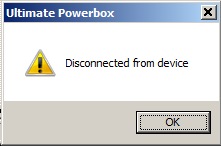 |
|
Can't detect a UPB controller (message when attempting to reconnect to PowerBox) |
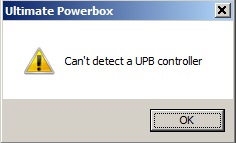 |
|
Device Manage listing directly after the event Shows COM3 instead of the Powerbox's usual COM6 |
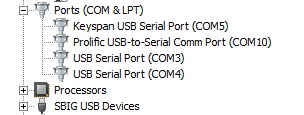 |
|
Data from Port Monitoring Log (COM 6 used by PowerBox dropped out and replaced by COM3 at 14:06) |
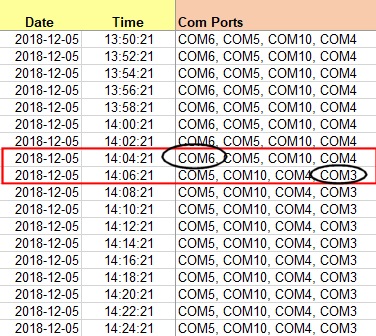 |
Back to Top
Given several events involving connection issues with the 12" LX200GPS/R since installing the scope in the dome I looked into potential solutions to improve things and came across a new piece of technlogy which was a Pierro-Astro USB-RS232 cable with integrated interface for LX200 (Product Page at Pierro-Astro). I bought one through www.astroshop.de (Product page at AstroShop) and it arrived today. The cable is 1.80m long and as a single piece it has the opportunity to replace the traditional 3 piece solution (custom serial cable, serial-USB interface, usb cable).
| Pierro-Astro USB-RS232 Cable for LX200 |
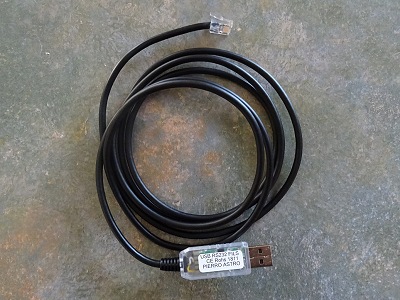 |
The cable is too short to connect back to USB Hub attached to the Observatory Computer (at least without a USB extension cable), but it can plug into a USB port on the recently acquired Ultimate PowerBox that is now attached to LX200's right hand fork arm. The cable does run the risk of being wrapped around the pier/wedge if the scope were to move clockwise beyond the North position, but this is the same risk already carried by the power and USB connection to the PowerBox. The cables are most 'happy' when operating in the NE, SE and SW quadrants.
There is a slight impediment to smooth movement of the cables due to the castellation on the cable retaining sleeve as it moves across the right hand arm of the wedge when the scope is moving in the NW quadrant but this is not enough to be a serious problem. The retaining sleeve is used to provide a bit more rigidity to the cable ensuring that hang away from the adjustments knobs on the wedge which are hazards for catching an otherwise loose/wandering cable.
Of more concern is that the cables gets pulled across the front of the mount's base and becomes quite tight when the scope is just west of North. Until a better configuration is developed an azimuth exclusion zone will be introduced which will exclude targets lying between 340 and 360 degs, unless I'm in the observatory and watching the cables. This will not be a significant issue for most observing targets.
One point of concern is that the integrated interface seems to use the same FDTI chip as in the Serial -USB interfaces used by the Pulsar Dome and Pegasus UPB controllers, for both of which I have encountered issues with their COM Port changing during operation on my particular (Windows 7) system, either apparently randomly or clearly in response to a momentary power interruption.
This concern was proved valid a few days later when a test was carried
out where the power switch on the USB Hub that is dedicated to the UPB PowerBox
was flipped (flipping the power switch to the UPB itself would have the same
effect based on past experience). The COM Port's for both UPB
PowerBox and the Pierro-Astro USB-RS232 interface both changed.
|
Data from Port Monitoring Log (COM 6 used by UPB PowerBox dropped out and replaced by COM3 at 15:50. At the same time COM7 used by Pierro-Astro USB-RS232 dropped out and replaced by COM8) |
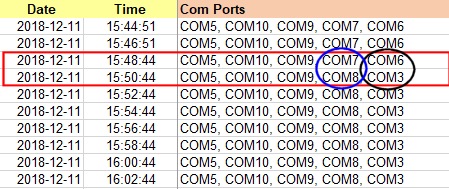 |
Back to Top
Following a proposed way foward that was set on 2018-12-05 and two further computer crashes on 2018-12-08 (02:30) and 2018-12-09 (06:11) a number of steps were then followed:
The System File Checker and Memory Checker didn't show up any problems. However the results of the memory checker couldn't be found after computer resumed windows operations. The Disk Checker (CHKDSK) showed up a couple of bad sectors (on none crictial files) which were automatically add to Bad Clusters File and discovered some free space that was marked as allocated in the master file table (MFT) and made corrections to the file system.
Results of the CHKDSK couldn't be viewed before Windows resumed its operations, but were accessed later by running the following command in PowerShell to place the results in a user accessible file.
get-winevent -FilterHashTable @{logname="Application"; id="1001"}| ?{$_.providername –match "wininit"} | fl timecreated, message | out-file C:\CHKDSKResults.txt
(from this article : https://www.download3k.com/articles/Chkdsk-Log-Location-in-Windows-7-8-10-01514 )
Computer resumed operations running AstroMain with basic services at
2018-12-11 02:40. Over the next 12-48 hours extra observatory services were
progressively added without any new computer crashes. The only item
not yet brought on line in the observatory is the LX200 telescope.
(it can be noted that a lot of the earlier crashes happening without the
LX200 Telescope being connected)
As at 2018-12-14 10:00 the
computer has now be running 3.3 days since it was restarted following the
System, Memory and Disk Checks.
Making a total of 5.1 days since the last
crash / unexpected restart. Progress but
(When Services were briefly stopped at 2018-12-11 20:29, two services failed with exceptions. These are noted as they're the first time these errors have been seen with these devices. They're most likely to be unrelated to the earlier computer crash issue
Focuser1: Fail The RPC server is unavailable. (Exception from HRESULT: 0x800706BA)
PowerBox Switch: Fail The RPC server is unavailable. (Exception from HRESULT: 0x800706BA)
Back to Top
A number of day-time observatory tests were conducted as part of continued investigation of COM Port switching issues seen on the Observatory Computer (Laptop9) and to understand the behaviour of the Dome Shutter in the event of a prolonged power grid outage.
Discussion:
Previous observations have shown the UPB
Software is unable to connect to UPB after COM Port has changed. The Observatory
Laptop has to be rebooted in order to reconnect to UPB (unless the recently
developed workaround is used whereby the UPB Software Process is killed and
UPB's COM Port set to the new Port using ASCOM.Profile, before relaunching the
UPB Software ).
In case of test 2 where the COM Port doesn't change , the user can dismiss the Disconnected from Device dialog message and click on the Connect Button to resume the connection. But should UPB Software previously assist automonous operation by automatically resuming the connection to the UPB if the UPB's COM Port comes back online ? Two schools of thought on this : -
It can be argued that UPB Software behaviour is the right one. It has
spotted that it has become disconnected from the device and has flagged this up
for the user to decide what to do next. Perfectly reasonable ?
However
having previously set Auto-Connect to on, it could be argued that the a user
might expect that the UPB software monitors the situation and if the Device's
USB-Serial Port reappears and becomes potentially reconnectable and the user
hasn't intervened then the UPB software should reconnect by itself.
Test 4 shows that in the event of a power cut during an observing session the Dome will automatically close itself. This is especially important for unattended operation. With the current setting this will occur after 5 minutes. There is a residual risk that rain could commence before the 5 minute period timeouts, however rain radar forecast from 'darksky.net' and monitored by the AstroWeather program (running on Laptop7) and communicated to the AstroMain Program (running on Laptop9) would hopefully catch the imminent rain threat and have commanded a closure of the shutter before the power cut occurs.
Other Items and Issues
Back to Top
| This Web Page: | Notes - Session 640 (2018-12-04) |
| Last Updated : | 2024-02-20 |
| Site Owner : | David Richards |
| Home Page : | David's Astronomy Web Site |